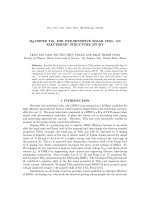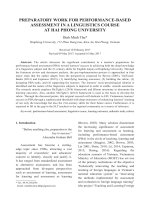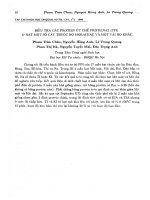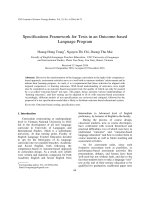DSpace at VNU: Mg-doped TiO2 for dye-sensitive solar cell: An electronic structure study
Bạn đang xem bản rút gọn của tài liệu. Xem và tải ngay bản đầy đủ của tài liệu tại đây (1 MB, 7 trang )
VNU Journal of Science, Mathematics - Physics 28 (2012) 84-93
Mg-doped TiO2 for dye-sensitive solar cell: An electronic
structure study
Tran Van Nam*, Nguyen Thuy Trang, Bach Thanh Cong
Faculty of Physics, Hanoi University of Science, 334 Nguyen Trai, Hanoi, Vietnam
Received 6 March 2012, received in revised from 25 May 2012
Abstract. Recently, there has been a renewed interest in TiO2 anatase as charge transfer layer in
dye-sensitized solar cells (DSSC). In this work, the electronic structure of Mg-doped TiO2 anatase
was explored in the framework of density functional theory (DFT). The results showed that the
substitution of Mg2+ ions for Ti4+ ions was quite easy in comparison with non metalic doping case.
It induced small lattice expansions about 0.3% along a and b axis and 0.1% along c axis which can
be explained in terms of internal stress around the impurity site and the anisotropic softy of the
material. The effects of Mg impurity on the bulk and surface electronic structures were also
discussed in details. It caused a negative shift of the conduction band edge -1.16 eV and 1.142 eV
for bulk and surface respectively. The Fermi level was also shifted 1 eV to the negative energy.
Such effects were suggested to improve short-circuit current JSC of DSSCs but decrease the opencircuit voltage VOC.
I. Introduction∗
Since the last decade, Dye-sensitized solar cells (DSSCs) has emerged as a brilliant candidate for
high efficiency photoelectric devices which required simple fabrication technology and possibly low
cost [1]. The most important component of a DSSC is a film of TiO2 nanocrystals mixed with dyesensitized molecules. It plays the crucial role in harvesting solar energy and generating photoelectric
current. Therefore, TiO2 has been intensively studied on purpose of increasing energy conversion
efficiency.
Doping TiO2 is a promissing way to improve DSSC efficiency because it can easily shift the band
edge and Fermi level of the material and thus change the electron transfer properties [2]. For example,
the band gap of TiO2 was 0.89 eV narrowed by S doping because of impurity states at the top of
valence band [3]. Iodine doping moved the mixed states of Ti 3d and O 2p 0.16 eV to higher energy
and thus reduced the band gap of the material [4]. Al, W-codoping [5] was reported to improve both
open-circuit voltage VOC and short-circuit current JSC of DSSCs by suppressing dark current and
_______
∗
Corresponding author. Tel.: 84- 939988292
E-mail:
84
85
T.V. Nam et al. / VNU Journal of Science, Mathematics-Physics 28 (2012) 84-93
improving electron trap-detrap mechanism, respectively. More recently, Liu et al. [6] and Feng et al.
[7] proposed Nb- and Ta-doped TiO2 nanomaterials for fabricating DSSCs. The Nb-doped TiO2
photoanode [8] exhibited a negative shift of the flat band potential of TiO2 and improved short-circuit
current. Meanwhile, Ta-doped TiO2 nanowire based DSSCs [9] have an open-circuit voltage improved
owing to the positive shift of the TiO2 Fermi level.
Information on electronic structure provides a good guideline to optimize efficiency of DSSCs via
doping way. Our work was aimed at getting a deep insight into the electronic structure of a Mg doped
TiO2 anatase material in the framework of density functional theory (DFT). Mg is of the alkaline earth
metallic series which were used to dope into TiO2 anatase in order to improved photoactivities of the
material [10]. The results in the literature showed that Mg is the best one of the series which can
substitute for Ti in bulk. In this paper, effects of Mg doping on electronic structure as well as electron
photo-injection and transportation will be discussed on the base of our ab initio calculation results.
2. Caculation details
This research was in the framework of density functional theory (DFT). In DFT method, the
electron energy is separated into several components: the kinetic energy ET, the electron-nuclear
interaction EV, the Coulomb repulsion EJ, and an exchange-correlation term EXC which accounts for
the remainder of electron-electron interaction (which is itself divided into separate exchange and
correlation components).
E = ET + EV + EJ + EXC
(1)
Then the variable principle requires that the distribution of electron density in the system should
minimize the energy of the system. Kohn-Sham equation [11], Schrodinger equation of DFT method,
was deduced in such way:
−∆ 2
− Vn + Ve + µ xc φi = ε iφi
2
(2)
Because of the mutation dependence between electron density and electron-electron interaction,
this equation can be solved by self-consistent field (SCF) scheme. In DFT method, all of the energy
components correspond to the classical energies of charge distribution except the last EXC. This
component arises from the anti-symmetry of the quantum mechanical wave function of electron
(exchange functional EX), and the dynamic correlation in the motions of the individual electrons
(correlation functional EC). With this inclusion, the DFT method achieves a significantly greater
accuracy than the Hartree-Fock (HF) method at only modest increase in computation time.
Our calculation was performed buy DMol3 package which provides a numerical basic set. The
Exchange-correlation potential is formulated by Pedrew and Wang (GGA-PWC) [12]. The KohnSham equation is solved with convergence criterion of total energy 10-6 (1Ha=27.21138 eV).
MonkhorstPack k-point meshes [13] of 3x3x3 and 2x4x1 were used for bulk and surface calculation,
respectively. The self-consistent electron potential terms were all electron Coulomb potentials which
86
T.V. Nam et al. / VNU Journal of Science, Mathematics-Physics 28 (2012) 84-93
included relativistic effects of core electrons. Relaxation processed was done until the residual forces
were below 0.002 Ha/Å and maximum energy change below 10-5 Ha. Such a Kohn-Sham equation and
SCF process were applied to the two following models. A P1 symmetric supercell of 2x2x1 I41/amd
unit cells (Fig. 1a, b) with three dimension periodic boundary condition (PBC) was used for bulk
calculations. In order to model doped bulk materials, one site of Ti was substituted by one impurity
atom, i.e. one Mg atom. Then the stoichiometric formula of the doped material is Ti15MgO32 which is
corresponding to 6.67% doping case. The second model was for (110) surface. It was composed of a
TiO2 slab which was cut along (110) direction and 8 Å thick embedded into vacuum which was 28 Å
thick (Fig. 2a, b). Stoichiometric formula of doped surface was Ti15MgO30 which means two-oxygenvacancy surface.
(a)
(c)
(b)
Fig. 1. Supercell structure of pure TiO2 (a) and doping Mg (b)
(a)
(b)
Fig. 2. Supercell for modeling TiO2 surface anatase (101): substitute Mg for Ti5C (a) and substitute Mg for
Ti6C (b).
87
T.V. Nam et al. / VNU Journal of Science, Mathematics-Physics 28 (2012) 84-93
3. Result and discussion
3.1. Calculations on pure TiO2 material
undoped
Fig. 3a shows the band structure of pure anatase TiO2. The calculated band gap is Eg
= 2.12
eV, which is smaller than the experimental one Egexp = 3.2 eV [14]. The optimized cells parameters are
a=b=3.813 Å c=9.78 Å which are larger than the experiment ones a=b=3.78 Å c=9.19 Å [15], those
are well-known failures of local density approximations in DFT.
(b)
(a)
Fig. 3. Band structure of bulk TiO2: non-doped (a) and doped Mg (b) (1 Ha=27.21138 eV).
(a)
(b)
Fig. 4. Density of states of pure TiO2 anatase (a) and Its electron deformationdensity (b).
88
T.V. Nam et al. / VNU Journal of Science, Mathematics-Physics 28 (2012) 84-93
The top of valence band (VB) approximately locates near the G-point and the bottom of the
conduction band (CB) locates at the G-point, which means that TiO2 anatase has an indirect band gap.
Our result is in good agreement with those ones of Ju-Young Park et al. Which predicted an indirect
band gap of 2.1 eV [16] and of Yin et al which gave rise to an indirect band gap of 1.88 eV [17]. Fig.
4a represents the density of states for pure TiO2. The core states are highly-dense and locate in a
narrow energy band between -26.5 eV and -23 eV. They are primarily oxygen 2p states (91%). There
are also 9% of them titanium 2p, 3d states. The VB locates between -13.5 eV and -7 eV. It is
composed mainly of the oxygen 2p states (83%) and titanium 3d states (17%). The CB ranging from 5.5 eV to -3 eV originates from titanium 3d states (92%) with the remaining small amount of oxygen
2p. According to this, the overlap between Ti states and O states is so small that the Ti-O bonding
should be considered to be strongly polarized or ionic. The electron deformation density ∆ρ shown in
Fig.4b gives a good visualization of the ionic nature of TiO2 crystal bonding. Here, ∆ρ is the
difference between electron density of TiO2 crystal ρ crystal and the total of electron density of isolated
atoms ρi : ∆ρ = ρcrystal −
∑ i ρ . The blue region around Ti atom is corresponding to
i
∆ρ < 0, i. e.
electron donating, and the red one around O atom is corresponding to ∆ρ > 0, i. e. electron accepting.
There is no shared electron region which is corresponding to covalence bonding between O and Ti.
The limitation of crystal by (110) surface gave rise to significant change in band structure as
observed from our calculation on vacuum slab supercell (Fig. 5a). It should be noted that there are two
oxygen vacancies on the as-built surface which would corresponding to 4-electrons doping if there
were no change in oxidization state of Ti. Actually, these electron-impurity states do not appear in the
calculated band structure. We suggest that these excess electrons oxidized the surface Ti4+ ions.
Consequently, the proportion of Ti 3d states between VB and CB is two times increased
approximately (in case of bulk TiO2 the contributions of Ti 3d states is 46% in VB and 54% in CB, on
the contrary the proportion is 64% and 36% in case of TiO2 surface) as shown in Ti 3d partial DOS
(Fig.5b). According to this, it is believe that Ti4+ ions were oxidized to Ti3+ as observed by previous
experiments [5]. There is a nearly separated band at the bottom of the CB which was not observed in
bulk TiO2. It belongs to surface Ti 3d states as deduced from the partial DOS analysis (Fig. 5). We
assign the separation of surface Ti 3d band to the transformation of octahedron-like to pyramid-like
coordination at surface due to surface oxygen vacancies.
3.3. Calculations on doped material
For the doped material, we calculated the substitution energy
Esub = EMg − doped + ETi −
E Non − dop − EMg . The substitution energy 8.2 eV for bulk material which is smaller than that of P
substitution (12.08 eV) implies that Mg substitution reaction is easier than P one [18]. In contrast, the
substitution energy is negative and quite large in value in case of surface site substitution, indicating
that the substitution reaction can naturally occur. Alkaline earth doped TiO2 compounds were prepared
by Yuexiang Li et al [10]. It was observed that the substitution was the easiest for Mg2+ case while
Be2+ tended to insert into interstitial site, Ca2+ was harder to substitute Ti4+ and able to induce lattice
T.V. Nam et al. / VNU Journal of Science, Mathematics-Physics 28 (2012) 84-93
89
deformation. The large ions, i. e. Ba2+ and Sr2+ hardly insert into crystal lattice and prefer to stay on
surface.
The calculated average unit cell sizes are 0.3% increased for a and b and 0.1% for c, i.e.
a=b=3.825 Å c= 9.792 Å when one Ti in 2x2x1 supercell is substituted by one Mg (Table. 1). The
increase of lattice parameter can be explained in term of local lattice distortion induced by impurity
site. The ionic radius of Mg2+ rMg 2+ = 0:86 Å [19] is larger than Ti4+ rTi 4+ = 0:74:5 Å [19]. Then the
substitution of the larger ion for the smaller ion led to an internal stress around the impurity site.
ERROR: stackunderflow
OFFENDING COMMAND: ~
STACK:









